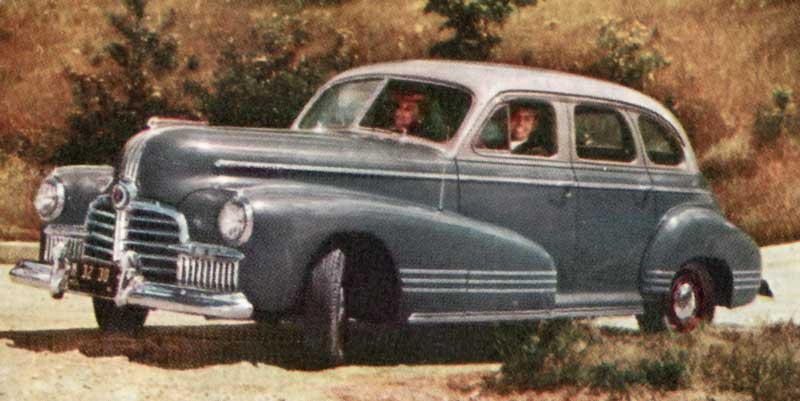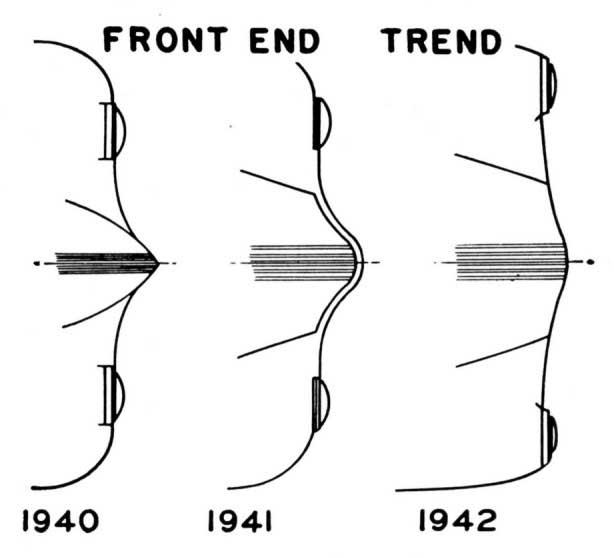
Pontiac Motor Division was already at work producing armament for national defense when the 1942 models were released. The sales brochures and magazine advertising explained Pontiac Division’s commitment to war production while touting the well deserved reputation for longevity and reliable service of its automobiles. The advertising was careful to note that the 1942 models were not compromised in any way by material restrictions then in place. This was not the case for some manufacturers; aluminum was in such short supply due to aircraft production that automotive pistons changed back to steel alloy in some cases!
During 1941 nickel became a critical material and the process for chrome-plating was changed to reduce the amount required by 50%. These parts were being used on late ’41 models and carried into 1942. When copper shortages became apparent, the Office of Price Management and automobile manufacturers’ met and agreed on October 27th, 1941 that only bumpers would be plated after December 15th, all other trim would have to be painted or deleted. It was becoming increasingly apparent that all automobile production would likely cease for the duration of the war and any car purchased had better be able to last as long as necessary. Pontiac was ready!
The Pontiac line for 1942 consisted of 2 series; the Torpedo and the Streamliner, built on the Fisher “A” and “B” bodies, respectively. The Torpedo series offered 3 sedans, 3 coupes and a convertible all riding on a 119” wheelbase chassis. The Streamliner series offered a 4 door sedan, a 2 door sedan coupe and a station wagon on a 122” wheelbase chassis and a choice of 2 interior trim levels. The standard trim models were identified simply as Streamliners; the upgrade models were Streamliner-Chieftains. The 3 seat station wagon was a Streamliner; the 2 seat model was the Streamliner-Chieftain. The “C” body models, introduced in 1940 and shared with Buick, Oldsmobile and Cadillac were dropped as Pontiac sought to simplify its product line.
Torpedo model upholstery for the closed cars was either novelty weave wool cloth in mixed shades of brown or Canda cloth featuring narrow pin stripes. The convertibles were available with 4 choices of colored leather and tan whipcord or completely done in Bedford cloth. The Streamliners were upholstered in Rendezvous Grey broadcloth with pin stripes; the Streamliner-Chieftains in either tan or blue-grey broadcloth with shadow pin stripes. Streamliner station wagons got tan imitation leather while the “Chieftain” wagons were a mixture of wool and genuine leather. A new 2 spoke steering wheel was standard equipment and allowed an excellent view of the restyled dashboard.
The instrument panel lights were now controlled exclusively by the headlight switch; no other switch was necessary. New for ’42 was the rheostat built into the headlight switch that allowed the driver to change the intensity of the panel lights by rotating the knob. The other noticeable change on the dashboard was the elimination of the hand throttle; improvements in the choke and fast idle linkage rendered it unnecessary.
New in the Torpedo series was the slant-back Sedan Coupe; a sales success in 1941 that had not been available on the A-body that year. The Metropolitan sedan remained in the line-up; offering modern 4 window styling in a 4 door sedan. The standard 4 door sedan featured 6 windows; a look dating back to the first 4 door sedans Pontiac ever built.
The Streamliner series offered 6 models in 3 body styles; a 6 window 4 door sedan, the 2 door sedan coupe and a station wagon. The Streamliner-Chieftain sedan and coupe featured the Safti-Flex steering wheel, electric clock, front bumper guards and rear seat center arm rests as standard equipment. These items remained available options of the station wagon. Badges on the front fenders just behind the wheel openings denoted the upgraded Chieftain trim package.
During 1941 nickel became a critical material and the process for chrome-plating was changed to reduce the amount required by 50%. These parts were being used on late ’41 models and carried into 1942. When copper shortages became apparent, the Office of Price Management and automobile manufacturers’ met and agreed on October 27th, 1941 that only bumpers would be plated after December 15th, all other trim would have to be painted or deleted. It was becoming increasingly apparent that all automobile production would likely cease for the duration of the war and any car purchased had better be able to last as long as necessary. Pontiac was ready!
The Pontiac line for 1942 consisted of 2 series; the Torpedo and the Streamliner, built on the Fisher “A” and “B” bodies, respectively. The Torpedo series offered 3 sedans, 3 coupes and a convertible all riding on a 119” wheelbase chassis. The Streamliner series offered a 4 door sedan, a 2 door sedan coupe and a station wagon on a 122” wheelbase chassis and a choice of 2 interior trim levels. The standard trim models were identified simply as Streamliners; the upgrade models were Streamliner-Chieftains. The 3 seat station wagon was a Streamliner; the 2 seat model was the Streamliner-Chieftain. The “C” body models, introduced in 1940 and shared with Buick, Oldsmobile and Cadillac were dropped as Pontiac sought to simplify its product line.
Torpedo model upholstery for the closed cars was either novelty weave wool cloth in mixed shades of brown or Canda cloth featuring narrow pin stripes. The convertibles were available with 4 choices of colored leather and tan whipcord or completely done in Bedford cloth. The Streamliners were upholstered in Rendezvous Grey broadcloth with pin stripes; the Streamliner-Chieftains in either tan or blue-grey broadcloth with shadow pin stripes. Streamliner station wagons got tan imitation leather while the “Chieftain” wagons were a mixture of wool and genuine leather. A new 2 spoke steering wheel was standard equipment and allowed an excellent view of the restyled dashboard.
The instrument panel lights were now controlled exclusively by the headlight switch; no other switch was necessary. New for ’42 was the rheostat built into the headlight switch that allowed the driver to change the intensity of the panel lights by rotating the knob. The other noticeable change on the dashboard was the elimination of the hand throttle; improvements in the choke and fast idle linkage rendered it unnecessary.
New in the Torpedo series was the slant-back Sedan Coupe; a sales success in 1941 that had not been available on the A-body that year. The Metropolitan sedan remained in the line-up; offering modern 4 window styling in a 4 door sedan. The standard 4 door sedan featured 6 windows; a look dating back to the first 4 door sedans Pontiac ever built.
The Streamliner series offered 6 models in 3 body styles; a 6 window 4 door sedan, the 2 door sedan coupe and a station wagon. The Streamliner-Chieftain sedan and coupe featured the Safti-Flex steering wheel, electric clock, front bumper guards and rear seat center arm rests as standard equipment. These items remained available options of the station wagon. Badges on the front fenders just behind the wheel openings denoted the upgraded Chieftain trim package.

An interesting item appeared in the Pontiac Owner’s Magazine dated October, 1941 and featuring the ’42 model line. It was a diagram showing the front ends of ‘40 through ‘42 Pontiacs from the perspective of overhead looking straight down. It is clear to see that the styling was becoming more flattened across the front with ever greater distance between the headlamps.
Pontiac again offered the straight eight for an additional $25 over the cost of the six cylinder engine in every model of either series. This policy began in 1941 and was unique to Pontiac. Pontiac six and eight cylinder engines remained essentially unchanged from the previous year. The standard compression ratio was 6.5:1 for both engines; a high compression cylinder head (7.5:1) was available on either engine to take advantage of increasingly available Ethyl gasoline. The patented Pontiac oil cleaner, also introduced in 1941, was improved by more than doubling the capacity of the sediment bowl to insure that it wouldn’t require any scheduled service. Eight cylinder engines featured the Carter WDO 2 barrel carburetor and compound vacuum booster fuel pump as standard equipment; the sixes continued with a Carter single barrel carburetor. The vacuum booster fuel pump was optionally available, either factory or dealer installed.
Chassis improvements made for the closed models were slight; the front brake shoes were enlarged and the rear spring leaves featured oil-impregnated separators to eliminate squeaks. Full metal spring covers remained standard equipment. The Torpedo convertible frame was significantly strengthened to reduce unwanted flexibility; this was accomplished by increased metal thickness which added over 70 pounds to the weight of the frame. The standard axle ratio for the Torpedo line was 4.10:1 and 6.00x16 tires were fitted. The larger and heavier Streamliner models rode on 6.50x16 tires paired with a 4.30:1 axle ratio. Either chassis was available with a 3.90:1 “economy” axle ratio; this option required that the engine be fitted with the high compression cylinder head. The additional cost of premium Ethyl gasoline was more than offset by the increased fuel economy these 2 options provided.
The most notable accessory was the refined heater and ventilation system that utilized a blower to force air into the passenger compartment even if the vehicle was standing still. Another new feature of this system that would remain a Pontiac staple was the use of a thermostatically controlled water valve that increased or decreased the flow to the heater in response to the temperature of outside air entering the system. This type of valve remained in use through 1954 on factory installed under-seat heaters.
The federal government ordered a halt to civilian automobile production in February, 1942. According to the photo and story in the February 16, 1942 issue of Life Magazine: “At exactly 1:31p.m. on February 2, the last pleasure car that will be made until the war is won rolled off the assembly line in Pontiac’s Plant A.”
Despite its short model run a total of 83,555 1942 Pontiacs were produced. The Torpedo Six accounted for 29,886 units; the Torpedo Eight count was 14,421; the Streamliner Six was 10,284; the Streamliner-Chieftain Six was 2,453; the Streamliner Eight was 15,465 and the Streamliner-Chieftain Eight was 11,041. The trend toward large, eight cylinder automobiles was already underway based upon these figures.
Pontiac again offered the straight eight for an additional $25 over the cost of the six cylinder engine in every model of either series. This policy began in 1941 and was unique to Pontiac. Pontiac six and eight cylinder engines remained essentially unchanged from the previous year. The standard compression ratio was 6.5:1 for both engines; a high compression cylinder head (7.5:1) was available on either engine to take advantage of increasingly available Ethyl gasoline. The patented Pontiac oil cleaner, also introduced in 1941, was improved by more than doubling the capacity of the sediment bowl to insure that it wouldn’t require any scheduled service. Eight cylinder engines featured the Carter WDO 2 barrel carburetor and compound vacuum booster fuel pump as standard equipment; the sixes continued with a Carter single barrel carburetor. The vacuum booster fuel pump was optionally available, either factory or dealer installed.
Chassis improvements made for the closed models were slight; the front brake shoes were enlarged and the rear spring leaves featured oil-impregnated separators to eliminate squeaks. Full metal spring covers remained standard equipment. The Torpedo convertible frame was significantly strengthened to reduce unwanted flexibility; this was accomplished by increased metal thickness which added over 70 pounds to the weight of the frame. The standard axle ratio for the Torpedo line was 4.10:1 and 6.00x16 tires were fitted. The larger and heavier Streamliner models rode on 6.50x16 tires paired with a 4.30:1 axle ratio. Either chassis was available with a 3.90:1 “economy” axle ratio; this option required that the engine be fitted with the high compression cylinder head. The additional cost of premium Ethyl gasoline was more than offset by the increased fuel economy these 2 options provided.
The most notable accessory was the refined heater and ventilation system that utilized a blower to force air into the passenger compartment even if the vehicle was standing still. Another new feature of this system that would remain a Pontiac staple was the use of a thermostatically controlled water valve that increased or decreased the flow to the heater in response to the temperature of outside air entering the system. This type of valve remained in use through 1954 on factory installed under-seat heaters.
The federal government ordered a halt to civilian automobile production in February, 1942. According to the photo and story in the February 16, 1942 issue of Life Magazine: “At exactly 1:31p.m. on February 2, the last pleasure car that will be made until the war is won rolled off the assembly line in Pontiac’s Plant A.”
Despite its short model run a total of 83,555 1942 Pontiacs were produced. The Torpedo Six accounted for 29,886 units; the Torpedo Eight count was 14,421; the Streamliner Six was 10,284; the Streamliner-Chieftain Six was 2,453; the Streamliner Eight was 15,465 and the Streamliner-Chieftain Eight was 11,041. The trend toward large, eight cylinder automobiles was already underway based upon these figures.

